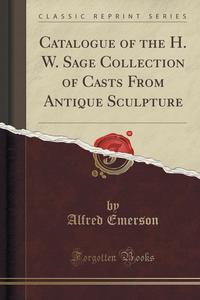Excerpt from Catalogue of the H. W. Sage Collection of Casts From Antique Sculpture
Thenceforth the age, the works, and the personal figure of Pheidias of Athens, as the greatest, if not the most advanced of all Greek sculptors, have occupied the foreground of archaeological discussion and supplied the central chapter in the history of Greek art. The term early Greek sculpture is now applied only to works earlier than the period of Perikles and Pheidias. The absolute predominance of Attic art over that of the remaining cantons of continental Greece, of Sicily and Magna Gr?cia in Italy, of the Greek islands, Asia Minor, and as far as the Scythian shores of the Black Sea dates from about 400 B. C.
The Aiginetan Marbles.
The character of earlier Greek sculpture, and the relatively high excellence, coupled with a masculine severity, to which it had attained in some of the Dorian communities of Greece about the time of the Persian Wars, was clearly indicated by the literary testimony of Antiquity. The critical correlation of this testimony with the extant and newly discovered concrete remains of antique art constitutes a large part of the science of classical archaeology. Early Greek art had, however, not been revealed to the eyes of scholars in an original example until the discovery in 1811, by a syndicate of German, English and Danish explorers, of the since widely known Aiginetan marbles. This title designates a series of fifteen lifesize statues and numerous fragments which once formed the sculptural decoration of a Doric temple of Athena 011 the prosperous Dorian island of Aigina not far from Athens.
They were incorporated by purchase in the sculpture gallery of Prince, afterwards King Louis (I.) of Bavaria, in Munich, (the Glyplothek), who had them restored by Thorvaldsen in close adherance to the primitive style of their first execution.
Archaic Greek Art.
These pieces supply the most familiar illustration of what is implied in the term archaic (early), so commonly employed in the discussion of the history and development of Greek art.
About the Publisher
Forgotten Books publishes hundreds of thousands of rare and classic books. Find more at www.forgottenbooks.com
This book is a reproduction of an important historical work. Forgotten Books uses state-of-the-art technology to digitally reconstruct the work, preserving the original format whilst repairing imperfections present in the aged copy. In rare cases, an imperfection in the original, such as a blemish or missing page, may be replicated in our edition. We do, however, repair the vast majority of imperfections successfully; any imperfections that remain are intentionally left to preserve the state of such historical works. Это и многое другое вы найдете в книге Catalogue of the H. W. Sage Collection of Casts From Antique Sculpture (Classic Reprint)
